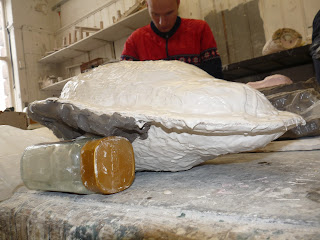The day after the second silicone layer has been applied the silicone rubber should be completely dry. So next we build a clay wall like so....with divots, don't forget the divots!!
First layer of Jesmonite.
Jesmonite is a composite material used in fine arts, crafts, and construction. Jesmonite consists of a gypsum-based material in an acrylic resin.
Jesmonite is a versatile material and is used in several different ways. It is typically used for creating sculptures and other three-dimensional works.It can be used for casting and laminating. It is considered durable, flame resistant, and resistant to impact. It can be used to fabricate both small and large objects. When mixed, it accepts coloured pigments and metal powders. Its surface can be finished to resemble plaster, stone, metal, and wood. (Thank you Wikipedia!!)
I am using it because it is a harder more durable material than plaster. It is also lighter once dry, which is perfect for larger sculptures. AND it dries slower than plaster which makes it slightly easier to work with. The typical ratio of Jesmonite mix is 3 to 1, but once again be sure to follow any instructions carefully.
Cut scrim into strips.
Apply a layer of scrim and Jesmonite.
Four to five layers of Jesmonite later when the lip is thick enough we leave the first 1/2 of the sculpture Jesmonite layer to dry over night.
Next day...
The whole sculpture is removed from the armature stand and flipped over to repeat the first Jesmonite sequence on the reverse side of the sculpture.
This is then also left to harden over night. We are now ready to reveal the mold!! And see if all this hard work has paid off......fingers crossed!!










No comments:
Post a Comment